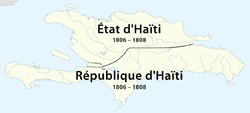State of Haiti | |||||||||
|---|---|---|---|---|---|---|---|---|---|
| 1806–1811 | |||||||||
 The State of Haiti in the north of Hispaniola before 1808 | |||||||||
| Capital | Milot | ||||||||
| Common languages | French, Haitian Creole | ||||||||
| Religion | Roman Catholicism | ||||||||
| Demonym(s) | Haitian | ||||||||
| Government | Unitary stratocratic autocracy | ||||||||
| President | |||||||||
• 1806–1811 | Henri Christophe | ||||||||
| History | |||||||||
• Assassination of Emperor Jacques I | 17 October 1806 | ||||||||
• Proclamation of Henri Christophe as King Henri I | 28 March 1811 | ||||||||
| Currency | Haitian livre | ||||||||
| |||||||||
| Today part of | Dominican Republic Haiti | ||||||||
The State of Haiti[1][2] (French: État d'Haïti;[3] Haitian Creole: Leta an Ayiti) was the name of the state in northern Haiti.[4] It was created on 17 October 1806 following the assassination of Emperor Jacques I and the overthrow of the First Empire of Haiti. The northern State of Haiti was ruled by Henri Christophe originally as Provisional Chief of the Haitian Government from 17 October 1806 until 17 February 1807 when he became President of the State of Haiti. The 1807 constitution for the State of Haiti made the post of president a position for life with the president having the power to appoint his successor. On 28 March 1811 President Henri was proclaimed King Henri I, thereby dissolving the State of Haiti and creating the Kingdom of Haiti.
Following the assassination of Emperor Jacques I, the country was split. Parallel with the government of Christophe in the north, Alexandre Pétion, a free person of color, ruled over the south of the country as President of the Republic of Haiti until his death in 1818. He was succeeded by Jean-Pierre Boyer, who reunited the two parts of the nation after the deaths of Henri I and Henri I's son, Jacques-Victor Henry, in 1820.
- ^ Cole, Hubert (1967). Christophe, King of Haiti. Viking Press. ISBN 978-0-670-00280-1.
- ^ Premdas, Ralph R. (1993). The Enigma of Ethnicity: An Analysis of Race in the Caribbean and the World. University of the West Indies, School of Continuing Studies.
- ^ Martens, Georg Friedrich (1842). 1806–1839 (in French). Dieterich.
- ^ Haiti), Henri Christophe (King of (1952). Henry Christophe & Thomas Clarkson: A Correspondence. University of California Press.

